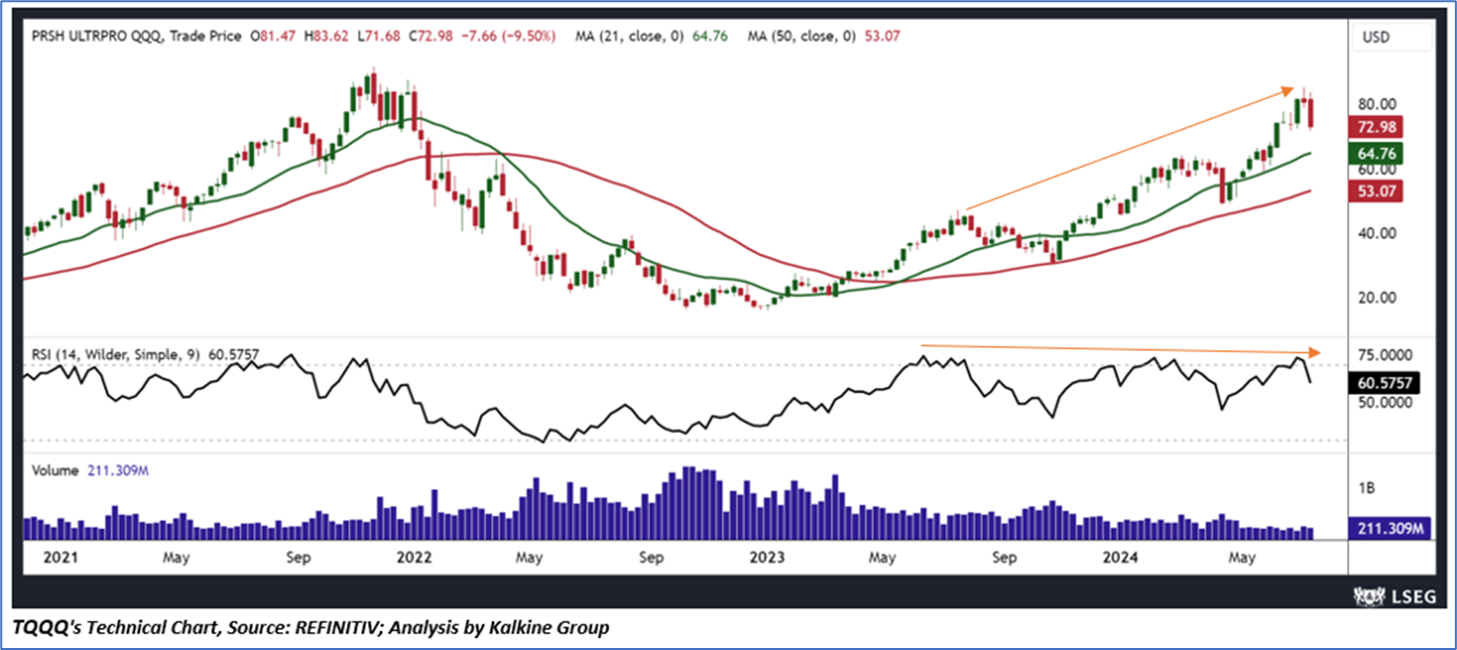
ProShares UltraPro QQQ
The Fund seeks daily investment results that correspond to three times (3x) the return of the Nasdaq-100 Index for a single day, not for any other period. The Index includes 100 of the largest domestic and international non-financial companies listed on The Nasdaq Stock Market based on market capitalization.

Technical Observation (on the weekly chart):
TQQQ's ascent has reached a critical juncture, with the stock's price faltering in the face of stiff resistance. This downturn is accompanied by a widening gap between the stock's performance and its momentum indicators, hinting at a potential inflection point in the near term. The 14-day Relative Strength Index (RSI) has begun to unwind its excessive enthusiasm and may continue to descend towards its mean, while TQQQ currently trades above its short-term and medium-term moving averages. These averages have historically served as a safety net for the stock's price, providing a cushion against further declines. As a result, it is probable that TQQQ will find a footing at these levels, allowing it to regroup before resuming its upward momentum.


Individuals can evaluate the ETF based on the support and resistance levels provided in the report in case of keen interest taking into consideration the risk-reward scenario.
Markets are trading in a highly volatile zone currently due to certain macro-economic issues and prevailing geopolitical tensions. Therefore, it is prudent to follow a cautious approach while investing.
Related Risk: This report may be looked at from a high-risk perspective and a recommendation is provided for a short duration. This report is solely based on technical parameters, and the fundamental performance of the ETFs has not been considered in the decision-making process. Other factors which could impact the ETF prices include market risks, regulatory risks, interest rates risks, currency risks, social and political instability risks etc.
How to Read the Charts?
The yellow colour line reflects the 21-period simple moving average (SMA) while the blue line indicates the 50- period simple moving average (SMA). SMA helps to identify existing price trends. If the prices are trading above the 21-period and 50-period moving average, then it shows prices are currently trading in a bullish trend.
The orange colour line in the chart’s lower segment reflects the Relative Strength Index (14-Period) which indicates price momentum and signals momentum in trend. A reading of 70 or above suggests overbought status while a reading of 30 or below suggests an oversold status.
The red and green colour bars in the chart’s lower segment show the volume of the ETF. The volume is the number of shares that changed hands during a given day. ETFs with high volumes are more liquid than ETFs with lesser volume as liquidity in ETFs helps with easier and faster execution of the order.
The Orange colour lines are the trend lines drawn by connecting two or more price points and used for trend identification purposes. The trend line also acts as a line of support and resistance.
Technical Indicators Defined: -
Support: A level at which the ETF prices tend to find support if they are falling, and a downtrend may take a pause backed by demand or buying interest. Support 1 refers to the nearby support level for the ETF and if the price breaches the level, then Support 2 may act as the crucial support level for the ETF.
Resistance: A level at which the ETF prices tend to find resistance when they are rising, and an uptrend may take a pause due to profit booking or selling interest. Resistance 1 refers to the nearby resistance level for the ETF and if the price surpasses the level, then Resistance 2 may act as the crucial resistance level for the ETF.
Stop-loss: It is a level to protect further losses in case of unfavourable movement in the ETF prices.
Past performance is neither an indicator nor a guarantee of future performance.
The reference date for all price data, currency, technical indicators, support, and resistance levels is Jul 18, 2024 (9:45 am PDT). The reference data in this report has been partly sourced from REFINITIV.
Abbreviations
CMP: Current Market Price
SMA: Simple Moving Average
RSI: Relative Strength Index
USD: United States dollar
Note: Trading decisions require a thorough analysis by individual. Technical reports in general chart out metrics that may be assessed by individuals before any ETF evaluation. The above are illustrative analytical factors used for evaluating ETFs; other parameters can be looked at along with additional risks per se. Past performance is neither an indicator nor a guarantee of future performance.
The advice given by Kalkine Canada Advisory Services Inc. and provided on this website is general information only and it does not take into account your investment objectives, financial situation and the particular needs of any particular person. You should therefore consider whether the advice is appropriate to your investment objectives, financial situation and needs before acting upon it. You should seek advice from a financial adviser, stockbroker or other professional (including taxation and legal advice) as necessary before acting on any advice. Not all investments are appropriate for all people. The website www.kalkine.ca is published by Kalkine Canada Advisory Services Inc. The link to our Terms & Conditions has been provided please go through them. On the date of publishing this report (mentioned on the website), employees and/or associates of Kalkine do not hold positions in any of the stocks covered on the website. These stocks can change any time and readers of the reports should not consider these stocks as advice or recommendations later.